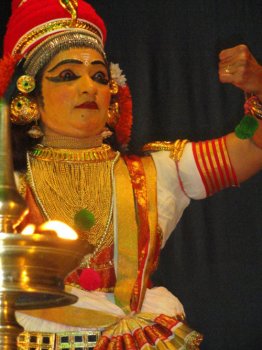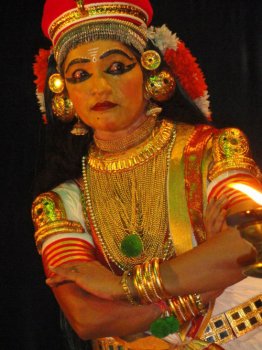
|   |

|   |
Tracing the agonies of Ahalya - Renu Ramanath e-mail: renuramanath@hotmail.com Photo: Vipin Chandran January 29, 2013 Ahalya is perhaps the most mysterious of all the Panchakanyas, the five Revered Women of the ancient Indian mythology. Many versions of her story exists in the different puranas, in some of which she is an innocent victim of treacherous seduction, in some others, she is a willing partner to Indra’s seduction of her.  Married to the Sage Gautama, by Brahma who created her, Ahalya lived a calm and disciplined life as an obedient wife to the great sage, performing her duties at the ashram devotedly, until the roving eyes of Indra, the king of gods, fell upon her. Enamoured of Ahalya’s beauty, Indra approached her in the guise of Gautama in his absence in order to satiate his lust. An enraged Gautama on discovering the treacherous act of Indra, inflicted curses not only upon Indra, but upon Ahalya too, cursing her to turn into a stone. As Ahalya begged for redressal, Gautama told her the footfall of Rama will redeem her. This is one version of the story of Ahalya. There are many more. All the versions revolve around whether Ahalya consciously committed adultery or not. Not many tell us of Ahalya’s own thoughts and feelings, especially after the curse fell upon her. Usha Nangiar, the renowned performer of Kutiyattam and Nangiarkoothu, in her interpretation of Ahalya in the Ahalyamoksham Nangiarkoothu, composed and choreographed by her, explores the mentalscape of Ahalya especially during the millions of years she was forced to spend in the form of a stone. Ahalya is the last of the Panchakanyas to be brought onto the stage by Usha Nangiar. The traditional repertory of Nangiarkoothu does not contain any of these characters, though Tara and Sita were brought onto stage a couple of decades back. Mandodari and Draupadi were performed by Usha later on. They were given life and blood by the imagination of Usha, who wanted to breathe life into these wonderful women characters from the Indian epics like Ramayana and Mahabharatha.  Bringing each of these characters onto the stage was a unique challenge which Usha Nangiar took up with diligence. Getting the appropriate sloka-s that contains references to the particular character was the first hurdle. For Ahalya, Usha Nangiar chose two slokas from Ramayana, one beginning ‘Sruthuva gurorithi….’ (taken from Margi Sathi’s Sreeramacharitham Nangiarkoothu) and the Ahalya Sthuthi beginning, ‘Namasthe Rama Rama…’ from Balakandam of Thunchath Ezhuthachan’s Adhyathma Ramayanam. For preparing the character of Ahalya, Usha Nangiar referred to many Sanskrit plays, which contained references to the incident of Ahalya Moksham. Though there are many versions of the story of Ahalya, in Usha Nangiar’s rendition, she is the virtuous and dutiful wife of the hermit who is treacherously cheated by the lustful Indra who tricks Gautama away for his morning bath. When Indra approaches Ahalya in the guise of Gautama, she is taken by surprise, yet obeys without a question, as is her practice. When the enraged Gautama curses her to be turned into a stone and remain without drinking or eating, she is shocked and begs for redemption. In Usha’s portrayal, Ahalya has a mind and sensory perceptions within the stony exterior. She is aware of everything that happens around, but unable to respond. She gets the pangs of hunger, but cannot eat. She feels thirst, but cannot quench it. She experiences the lashing rain, the biting cold and the scorching sun as seasons change, unable to shelter herself. And, throughout, she is fearing, what if Rama, her redeemer, walks past her without recognising her. The barely 75 minutes long performance was felt to be too short, giving rise to the feeling that the actor could have dwelled more into the thoughts and emotions raging within Ahalya during her penance through centuries. As always, Usha Nangiar embodied perfection in her each and every movement, even in the minutest move of an eyelid. The anguish of Ahalya, trapped within a stony façade, enacted from a seated position on the floor with only mukhabhinaya, was extremely touching. One major glitch was the light provided on the stage, with the two halogen lamps, casting ugly shadows on the actor’s face from the very beginning. Shadows kept dancing forth across the face throughout the performance, with only her excellent histrionics being able to overcome the hindrance. The mizhavu maestro V.K.K.Hariharan, accompanied by Kalamandalam Rajeev, led the actor and the audience along the nuances of thalam, enhancing and colouring the emotional landscape of the character. Kalanilayam Unnikrishnan accompanied on edakka, and Athira Hariharan kept thalam. The event was presented by Kochi-Muziris Biennale Foundation, at Changampuzha Park, Edappally. Renu Ramanath is an independent writer and columnist based in Kochi, specialising in visual and performing arts. |